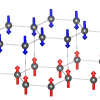
Researchers from the groups of Klára Uhlířová and Tim Verhagen have become the first to discover moiré ferroelectricity in single crystals of chalcogenides with incommensurate crystal structures [1], specifically in the model compound (PbS)₁.₁₁VS₂. Although this compound is non-polar in its stable form, numerous structural defects and twin domains lead to the formation of polar interfaces. These interfaces, while most easily observed on cleaved sample surfaces, extend throughout the entire crystal.
The phenomenon was first identified during the work on a bachelor thesis [2], though the path to publication [1] was a longer journey including detailed crystal structure characterization. A key strength of this discovery is that, unlike artificially engineered moiré lattices, ferroelectricity can now be studied in naturally grown single crystals with ultimately clean interfaces. Local material polarizability was demonstrated using piezoresponse force microscopy [2], and further studies—carried out during master’s and doctoral research—explored polarizability using electron beam lithography [4,5]. A subsequent study [6] even revealed catalytic behaviour linked to specific polar domain orientation. Electrical transport and other physical properties of these materials are currently under further investigation.
Moiré sliding ferroelectricity is a novel phenomenon found in van der Waals materials. First predicted theoretically in 2017 and experimentally confirmed two years later in artificial heterostructures, this effect opens new pathways for developing multiferroic materials with remarkable properties—such as ferroelectricity in metallic systems or negative piezoelectric responses—that are not possible in classical ferroelectrics.
Moiré structures can be relatively easily fabricated from individual layers of van der Waals materials (such as graphite and its famous 2D derivative, graphene). Thanks to the weak interlayer forces, these layers can be shifted or rotated with respect to one another. When rotated at small angles, a moiré pattern emerges—a phenomenon familiar from imaging systems, where it is often considered undesirable. However, when such structures are created at interfaces of materials with appropriate symmetry, they can give rise not only to ferroelectricity but also to a host of other fascinating physical effects.







